Showfoto/Curves Adjust/it: Difference between revisions
Updating to match new version of source page |
mNo edit summary |
||
| Line 6: | Line 6: | ||
{{Note_(it)|L'immagine originale utilizzata in questa guida [http://userbase.kde.org/File:Curves_adjust.jpg può essere trovata qui]. }} | {{Note_(it)|L'immagine originale utilizzata in questa guida [http://userbase.kde.org/File:Curves_adjust.jpg può essere trovata qui]. }} | ||
Questa è la seconda parte delle guide mirate a mostrare come utilizzare gli strumenti fotografici di KDE (cioè '''ShowFoto''' e/o '''Krita''') per elaborare, modificare e correggere le tue fotografie. La [[Special:myLanguage/Showfoto/Levels Adjust|prima parte delle guide]] mostrava come interpretare un ''istogramma'' e come utilizzare lo strumento ''livelli''. Questa guida ti mostrerà come utilizzare uno strumento più avanzato, chiamato strumento ''Regola curve''. È molto più potente rispetto ai livelli, ma richiede più pazienza e pratica per ottenere buoni risultati. | |||
Questa è la seconda parte delle guide mirate a mostrare come utilizzare gli strumenti fotografici di KDE (cioè '''ShowFoto''' e/o '''Krita''') per elaborare, modificare e correggere le tue fotografie. La [[Showfoto/Levels Adjust | |||
Dunque iniziamo. Questa volta abbiamo questa foto gentilmente donata per la guida da Jos van den Oever, dalle sue foto dell'akademy 2008. | Dunque iniziamo. Questa volta abbiamo questa foto gentilmente donata per la guida da Jos van den Oever, dalle sue foto dell'akademy 2008. | ||
Revision as of 18:17, 21 September 2010
Guida fotografica KDE 1-2: Regolare le curve
Unai Garro (uga) - estate 2008
Questa è la seconda parte delle guide mirate a mostrare come utilizzare gli strumenti fotografici di KDE (cioè ShowFoto e/o Krita) per elaborare, modificare e correggere le tue fotografie. La prima parte delle guide mostrava come interpretare un istogramma e come utilizzare lo strumento livelli. Questa guida ti mostrerà come utilizzare uno strumento più avanzato, chiamato strumento Regola curve. È molto più potente rispetto ai livelli, ma richiede più pazienza e pratica per ottenere buoni risultati.
Dunque iniziamo. Questa volta abbiamo questa foto gentilmente donata per la guida da Jos van den Oever, dalle sue foto dell'akademy 2008.
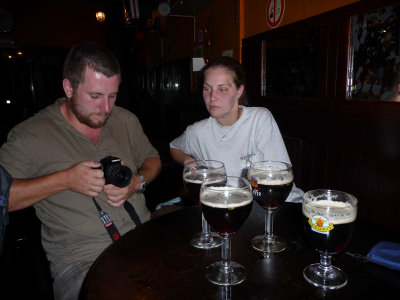
Di nuovo il problema in questa foto è che ci sono parti dell'immagine che sono molto scure. Le due persone sono chiare nella foto, ma lo sfondo è così scuro che non possiamo in effetti vedere i dettagli del pub. Vediamo cosa succede se proviamo ad utilizzare lo strumento livelli come abbiamo imparato nella prima guida:
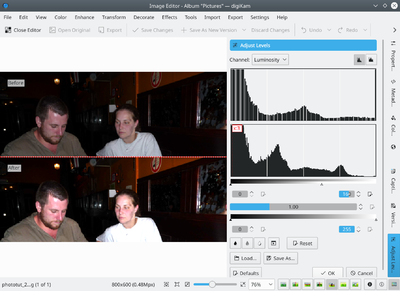
As you can see, some parts of the image get blown if we try using the levels tool. What does that mean? It means that we have parts of the image in the right hand of the histogram that have been all converted to white. That's because, unlike the previous tutorial, this image is not concentrated on the left part of the histogram. It covers the whole of it. And when clipping the histogram with the input sliders, we are "eating" part of the information.
Perché succede questo? Perché lo scenario della foto aveva un range dinamico veramente molto elevato (High Dynamic Range), cioè aveva oggetti molti scuri (sfondo) e molti chiari (illuminati dal flash).
In questo tipo di immagini, se proviamo a spostare i cursori dell'immagine in ingresso dello strumento livelli, cancelleremo parte dell'informazione del livello di grigio della foto, perdendo dettagli ed ottenendo un risultato non piacevole.
Dunque che fare ora? Possiamo utilizzare lo strumento dal menu : ![]()
Selezionando questa opzione verrà mostrata una nuova interfaccia che può sembrare simile allo strumento livelli. Puoi vedere l'istogramma risultante in alto e l'istogramma in ingresso in basso, proprio come nello strumento livelli:
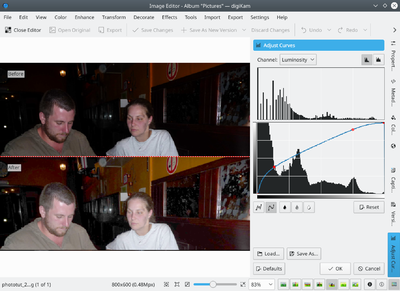
La differenza è nel modo in cui il controllo funziona. In questo strumento l'istogramma in ingresso contiene una linea diagonale. Facendo clic su di essa con il pulsante sinistro del mouse puoi aggiungere punti di controllo. Puoi muovere questi punti di controllo in alto e in basso. Il risultato, come mostrato nell'immagine sopra, è che i livelli di grigio dall'asse orizzontale vengono convertiti in livelli di grigio nell'asse verticale.
Muovere i punti di controllo in alto rende quella parte dell'immagine più chiara. Muoverli in basso rende quella parte dell'immagine più scura.
In this case, I wanted to make the darkest parts of the image brighter, so I added a control point on the left part of the histogram, and moved the point upwards. As the rest of the image was also getting a bit too bright, I added a second control point to avoid it.
So, lets press and see what we get of it:
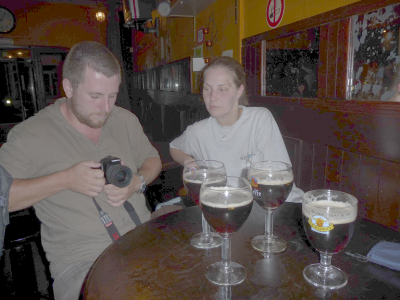
We have managed to make the shadows brighter, and now the pub is more visible, but the image is now a bit washed out. As if it were too bright all over the place. Can we do something? Sure, lets try the levels adjustment again:
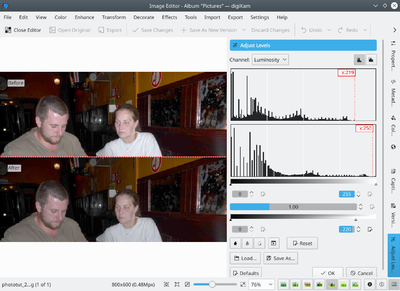
Now that the shadows were adjusted using the curves, and the colors are more uniform, we can follow the method shown in the first tutorial and adjust the levels of the photo, as shown above. The histogram's main data was a bit displaced to the left, and adjusting levels, I made it cover the whole range again.
Lets see the result - Ah, now this is much better. The pub background is much more visible and the two persons are not blown:
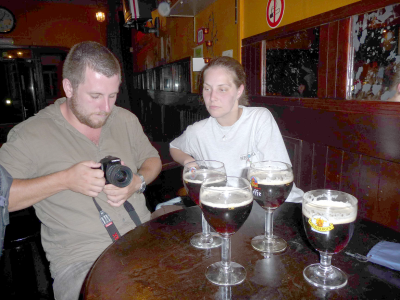
I think that's already acceptable, but if we are picky, the two people are a bit washed out due to the flash light. So, even if that goes out of the scope of this tutorial (it'll be covered in the following tutorials), lets adjust a bit the saturation and contrast in the image for a better result:
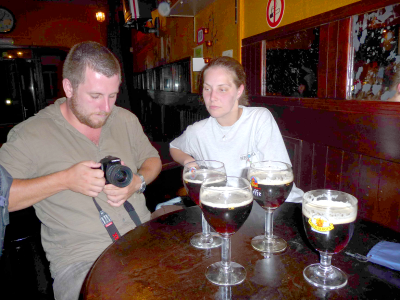
Now this image looks much nicer than the original, yes. I hope you liked this tutorial and will see you in the next one!

![40px]](/images.userbase/c/c1/Note-box-icon.png)